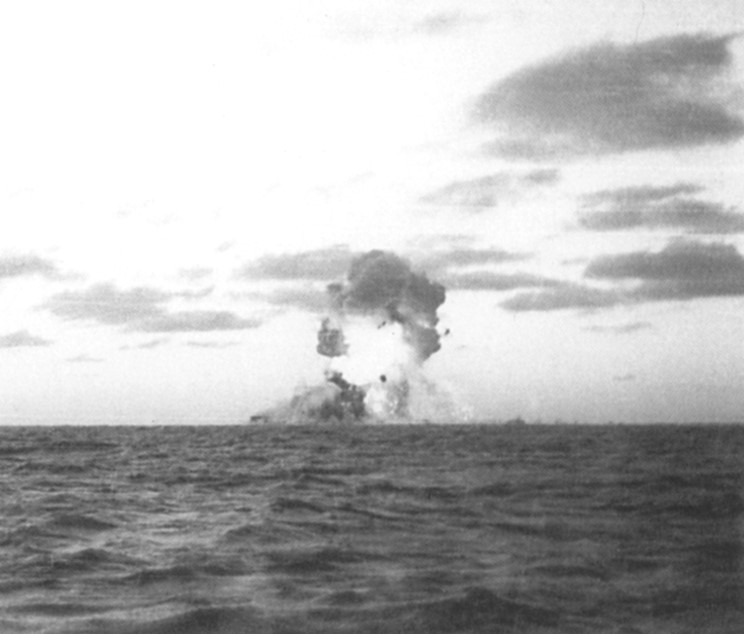|
December 13, 1939: Following the Battle of the River Plate the German Panzerschiff Admiral Graf Spee headed for port in Montevideo, Uruguay. In the battle with the British cruisers HMS Exeter, HMS Ajax and HMNZS Achilles, the Graf Spee had received almost twenty hits from the British ships killing thirty six of the crew. The British losses were greater. The Exeter lost sixty one crewmen and was effectively out of action because of the heavy damage she received. The Ajax, also severely damaged, had two turrets knocked out and seven crewmen killed. The Achilles fared the best with only minor damage and the loss of four crewmen. The captain of the Admiral Graf Spee, Hans Langsdorff, was under orders not to engage British warships but, Admiral Henry Harwood had trapped him off the coast and he had no option but to stand and fight. Of course Langsdorff had no idea of how badly the British ships were damaged when he made for port. Under International law the Graf Spee could only remain at a neutral port for twenty four hours, Langsdorff Messages had been flying back and forth between the German Ambassador in Montevideo and Berlin. Hitler informed Raeder that the Graf Spee must not under any circumstances be allowed to be interned in Montevideo. Raeder sent Langsdorff a message that in effect told him to fight his way out or scuttle the ship, it was his choice. After consulting the officers of the Graf Spee, Langsdorff made his decision. On the evening of the 16th they began to prepare the ship for scuttling. Vital and secret equipment on the ship was destroyed and charges were set all around the ship. The majority of the crew were transferred to the tanker Tacoma while other items, including the ship's bell and battle ensign, were taken ashore to be returned to Germany. While a quarter of a million people gathered on shore to watch what they were sure would be a great battle the Admiral Graf Spee weighed anchor. The ship began her departure at about 18:30 hours and headed for the open sea followed by the Tacoma. Just outside the breakwater the Tacoma stopped and transferred the crew to two waiting tugs from Argentina. Shortly after this action the Uruguayan Navy escorted the Tacoma back to The Admiral Graf Spee now outside the three mile limit dropped anchor. She sat there for about half an hour during which time the battle ensign's that were raised before she departed Montevideo were taken down and Langsdorff and the remaining crew members boarded the captains launch and moved away from the ship. The Admiral Graf Spee exploded sending the aft turret into the air and clear of the ship, severing the stern and wrecking the superstructure. The ship burning from stem to stern sank into the shallow waters off Montevideo. Langsdorff's final entry in the ship's log "Graf Spee put out of service on December 17, 1939 at 20:00 hours" Langsdorff and the crew were taken to Buenos Aries, Argentina but were interned as POW's. Brutally attacked in the press as a coward for not fighting or going down with his ship, Langsdorff knew his career as a German Naval Officer was over. Even though he and his crew had captured and sunk nine ships (without the loss of a single life on either side) before her tragic demise. On December 19 he met for one last time with the crew. He explained to them that he lacked no courage and chose to scuttle the ship to save the lives of hundreds of sailors who would have been killed for no reason in a battle they could not have won. After midnight Langsdorff dismissed himself and returned to his room. Alone and disheartened he lit a cigar and had a glass of scotch. On December 20, 1939, the third commander of the Admiral Graf Spee, Kapitän zur See Hans Langsdorff shot himself in the head. His funeral was attended by his crew and local officials. The captain of the SS Ashlea, a British ship, was also there on behalf of the British sailors who had once been held captive aboard the Graf Spee. This was a tremendous show of respect for an honorable adversary. |
© 2005 Michael W. Pocock MaritimeQuest.com |
 |
Panzerschiff Admiral Graf Spee exploding December 17, 1939.
|
 |
| Kapitän zur See Hans Langsdorff giving the traditional salute to the dead crewmen of the Admiral Graf Spee. (Notice that everyone else visible in the photo is giving the Nazi salute.) |